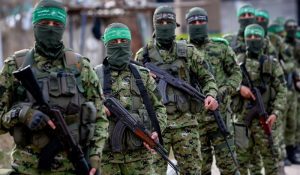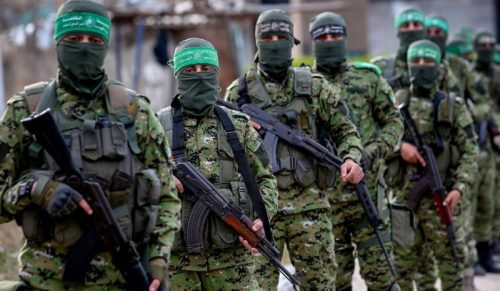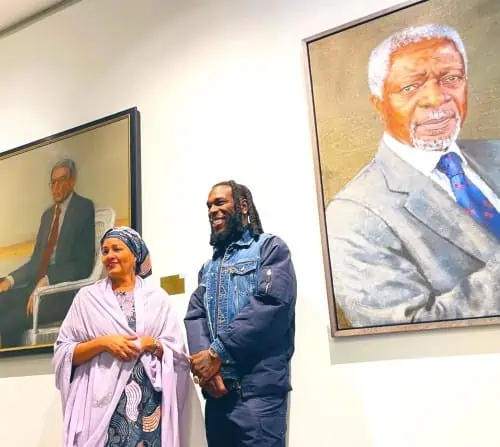
What is Hamas? A Comprehensive Guide to the Palestinian Militant Group. Hamas History, Power, Leadership, and Goals. A Palestinian Islamist Movement with a Military Wing.
On Saturday, October 7th, Hamas carried out an attack on Israel, leading to a renewed conflict between the two sides. Both sides have been using weapons, and civilian casualties are occurring. According to reports, this attack by Hamas against Israel is one of the largest to date. After the attack, Hamas fighters also infiltrated areas held by Israel. Hamas stated that they want to declare that “enough is enough.” Let’s learn more about Hamas, its establishment, leadership, key figures associated with Hamas, and its objectives in the Israel-Palestine conflict.
What is Hamas (حماس)?
Hamas, whose full name is Harakat al-Muqawama al-Islamiya, translates to the Islamic Resistance Movement. It is a political and militant organization operating in the Palestinian territories. Hamas is primarily composed of Sunni Muslims and is engaged in a long-standing conflict with Israel, seeking to regain control over territories that Israel captured years ago. It is also considered a nationalist movement. The primary goal of Hamas is to defeat Israel and establish control over areas that Israel took during past conflicts. Numerous rocket exchanges have occurred in these conflicts. Israel has conducted multiple airstrikes against Hamas, and, in collaboration with Egypt, imposed a blockade on the Gaza Strip since 2007. While Hamas governs over two million Palestinians in the Gaza Strip, it is primarily known for its armed resistance against Israel. Several countries, including the United States and the United Kingdom, label Hamas as a “terrorist organization.” In 1997, the United States designated Hamas as a foreign terrorist organization. Following Hamas’s attack on Israel on Saturday, October 7th, Indian Prime Minister Narendra Modi also labeled it as a “terrorist attack.”
Who Founded Hamas (حماس)?
Hamas was founded by Palestinian cleric Sheikh Ahmed Yassin, who, after receiving Islamic education in Cairo, became an activist in local branches of the Muslim Brotherhood. In the 1960s, Sheikh Ahmed Yassin provided religious guidance in the West Bank and Gaza after the 1967 Six-Day War, when Israel captured these territories. Sheikh Ahmed Yassin’s aim was to counterbalance the Muslim Brotherhood’s influence on Palestinian support. In December 1987, in response to Israel’s control over the West Bank, Gaza, and East Jerusalem, Sheikh Ahmed Yassin established Hamas as the political branch of the Muslim Brotherhood in Gaza. At that time, Hamas aimed to counter the Palestinian Islamic Jihad (PIJ), an organization that had threatened Palestinian support for the Brotherhood. In 1988, Hamas published its charter, which called for the establishment of an Islamic society in historic Palestine and rejected any permanent peace with Israel. Hamas views the current Israeli territory as Islamic land and rejects any lasting peace with the Jewish state. In 2004, Sheikh Ahmed Yassin, the founder of Hamas, was assassinated by the Israeli military.
Leadership and Key Figures Associated with Hamas (حماس)
Hamas published a new document in 2017, accepting the concept of an interim Palestinian state along the pre-1967 borders, known as the “Green Line,” before a six-day war. However, it still rejected recognition of Israel. This document also emphasized that Hamas’s struggle is not against Jews but against “occupying Zionists.” Israel claimed that Hamas was attempting to deceive the world.
Hamas (حماس) is led by various bodies, each responsible for different aspects of its political, military, and social activities. Hamas’s general policy is determined by a consultative body often referred to as the Politburo. Local committees manage grassroots issues in Gaza and the West Bank.
Ismail Haniyeh:
Currently, the political chief of Hamas is Ismail Haniyeh. He took over the leadership from Khalid Meshaal in 2017. Ismail Haniyeh has reportedly been based in Doha, Qatar, since 2020, as he faces travel restrictions both inside and outside Gaza. In 2011, Hamas leaders relocated to Qatar after participating in protests against the Syrian Civil War. Some senior Hamas figures are known to operate from offices in Turkey.
Yahya Sinwar:
In Gaza, day-to-day affairs are overseen by Yahya Sinwar, who previously led Hamas’s military wing. Yahya Sinwar had served a 22-year prison sentence in Israel for his involvement in the kidnapping and killing of two Israeli soldiers. He was released in exchange for over a thousand Palestinian prisoners, held by Israel, in 2011.
Marwan Issa and Mohammed Deif:
Hamas’s military wing, the Izz ad-Din al-Qassam Brigades, is commanded by Marwan Issa and Mohammed Deif. Salah Shehadeh, the founder of the militia, was killed in an Israeli airstrike in 2002.
Saleh al-Arouri:
Saleh al-Arouri is purportedly the head of Hamas’s Lebanon branch. He also assumed leadership of the group in the West Bank following the 2021 internal elections.
Meshaal and Salameh Katawi:
Meshaal leads the Hamas Political Bureau and is based in the Hamas diaspora office. Salameh Katawi is responsible for managing the affairs of imprisoned Hamas members.
Where does Hamas receive financial and military support?
The United States has officially designated Hamas as a terrorist organization and has cut off any official support. Currently, Iran is one of Hamas’s major backers, providing financial aid, weaponry, and training. However, Iran and Hamas had temporarily severed ties due to Iran’s support for opposing factions during the Syrian Civil War. As of now, Iran continues to provide substantial support to Hamas, as well as other Palestinian groups designated as terrorist organizations by the United States.
In 2018, the United States imposed sanctions on Iran, affecting its ability to financially support its foreign proxies. Turkey has also been a vocal supporter of Hamas since the rise of Recep Tayyip Erdogan to power in 2002. However, Ankara maintains that it supports Hamas only politically. Turkey has faced accusations of financially supporting Hamas as well.
What are Gaza Strip and West Bank?
The Gaza Strip and the West Bank are both Palestinian territories that were part of Mandatory Palestine. In 1967, Israel took control of these areas following the Six-Day War. Together, they are home to over five million Palestinians. The Gaza Strip is a small coastal territory measuring 140 square miles, located in the southwestern corner of Israel, bordered by the Mediterranean Sea to the west and Egypt to the south. The West Bank, in contrast, is a much larger territory, covering 2,173 square miles. It stretches from the western shores of the Jordan River to the majority of the Dead Sea. East Jerusalem, considered a holy city, is internationally recognized as part of the West Bank. The status of Jerusalem is a contentious issue, with both Israel and Palestine claiming it as their capital. Palestinians in both Gaza and the West Bank have lived under Israeli restrictions, and many rely on international assistance for basic needs like food, water, and supplies. The struggle for control over these regions has persisted for decades, with Palestinians seeking an independent state and sovereignty.
Hamas is a powerful force in Palestinian politics. It won the 2006 Palestinian legislative elections and controlled the Gaza Strip from 2007 to 2014. Hamas and Israel have fought four wars since 2008.
Hamas’s goals are as follows:
- To establish an Islamic Palestinian state in place of Israel, from the Jordan River to the Mediterranean Sea.
- To liberate all Palestinian territories from Israeli occupation, including the West Bank, East Jerusalem, and the Gaza Strip.
- To return all Palestinian refugees to their homes.
- To establish a just and equitable society based on Islamic law.
Hamas is a controversial organization. It has been designated as a terrorist organization by the United States, the European Union, Israel, and other countries. Hamas has been accused of human rights abuses, including the use of child soldiers and the indiscriminate firing of rockets into Israel.
However, Hamas also enjoys widespread support among Palestinians. It is seen by many Palestinians as a legitimate resistance movement against Israeli occupation. Hamas also provides important social services to the Palestinian people, such as healthcare, education, and poverty relief.
The future of Hamas is uncertain. The group is facing internal challenges, such as financial difficulties and divisions within its leadership. Hamas is also facing external challenges, such as the ongoing Israeli-Palestinian conflict and the blockade of the Gaza Strip. However, Hamas remains a powerful force in Palestinian politics, and it is likely to continue to play a significant role in the Israeli-Palestinian conflict.
RELATED POST: Best History of Palestine: From Ancient Times to the Modern State












